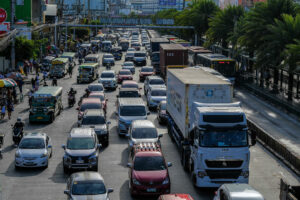EDSA rehabilitation starts mid-June
THE P8.7-billion rehabilitation of the Epifanio de los Santos Avenue (EDSA) is set to begin on June 13 and expected to be completed by 2027, the Department of Transportation (DoTr) said on Monday.

By Ashley Erika O. Jose, Reporter
THE P8.7-billion rehabilitation of the Epifanio de los Santos Avenue (EDSA) is set to begin on June 13 and expected to be completed by 2027, the Department of Transportation (DoTr) said on Monday.
The DoTr outlined plans to address the traffic congestion that is expected to worsen once parts of Metro Manila’s busiest highway will be closed for rehabilitation work.
“We will rebuild EDSA. This project by the Department of Public Works and Highways (DPWH) will rehabilitate the full stretch of EDSA and make it a green and walkable highway. We need to change the entire concrete structure of EDSA,” Transportation Secretary Vivencio B. Dizon said at a media briefing on Monday.
The EDSA rebuild project, which will run for two years, will be the highway’s first major rehabilitation since 1980. Around 437,000 vehicles use EDSA every day.
Public Works Secretary Manuel M. Bonoan said the project aims to make Metro Manila’s longest and most congested highway a more pedestrian and commuter-friendly road.
Preparatory works will begin on the night of June 13, while construction will go full blast a week after, Mr. Bonoan said. This will include laying out the sections as the rehabilitation project is intended to be implemented lane by lane.
“The concept of the rebuild project, our deliverables are to rebuild and reconstruct the entire EDSA. We will change the pavement into a new one, in other words we will flip the entire EDSA and adapt the latest technologies on concrete mix,” Mr. Bonoan said.
“We will deploy several contractors simultaneously. Construction will proceed lane by lane.”
Overall, a total of 200 kilometers of lane covering both northbound and southbound of EDSA will be rehabilitated, Mr. Bonoan said, adding that the south portion will be done first, followed by the northbound section next year.
“I do not think we can finish the southbound portion this year because it is already the middle of the year. We will continue the implementation of southbound and northbound until next year, simultaneously,” Mr. Bonoan said.
Starting mid-June, the government will work on the excavation of the existing surface and installation of new concrete, prioritizing the sections of Pasay and Guadalupe.
Mr. Bonoan said the EDSA Bus Lane, which serves nearly 200,000 average daily passengers, will continue to operate during the rehabilitation period.
He said the government is prioritizing the south portion of EDSA due to the country’s anticipated hosting of the Association of Southeast Asian Nations (ASEAN) Summit in 2026 which is expected to be held in the south of Metro Manila.
“Our consideration for this scheme is the ASEAN meeting. We will have to avoid the construction in EDSA during that time,” Mr. Bonoan said.
TRAFFIC MANAGEMENT
DoTr’s Mr. Dizon said that San Miguel Corp. (SMC) had agreed to waive the toll fee for some segments of the Skyway Stage 3 during the EDSA rehabilitation period.
“We understand that this temporary arrangement might result in loss of income to SMC, the operator of Skyway. In response, the DoTr and Toll Regulatory Board are exploring options to grant SMC some reprieve, including possible extension of their concession agreement with the government,” he said.
BusinessWorld also sought comment from SMC but it has yet to respond as of the deadline.
“The free toll will begin once the full blast of construction starts, so maybe that is July or August,” Mr. Dizon said.
The DoTr and the Metropolitan Manila Development Authority (MMDA) have also developed their initial traffic mitigation plans which include the deployment of 100 units of bus on EDSA Busway; and more trains at Metro Rail Transit Line 3 (MRT-3).
MMDA Chairman Romando S. Artes said the odd-even scheme for private cars will also be strictly implemented along EDSA for a 24-hour period except on Sundays.
Under this scheme, private cars with plates ending in odd digits will be barred from using EDSA during Mondays, Wednesdays, and Fridays, while vehicles with plate numbers ending in even numbers cannot use EDSA on Tuesdays, Thursdays, and Saturdays.
“With this scheme, we expect a 40% reduction of vehicles in EDSA. The existing coding schemes will continue to be in place for roads outside EDSA,” Mr. Artes said.
Electric vehicles, and hybrid cars are exempted from the number coding scheme, under the Electric Vehicle Industry Development Act (EVIDA) in the Philippines.
Transportation Network Vehicle Service (TNVS) like Grab and inDrive are also exempted from the odd-even scheme on EDSA.
Further, trucks and provincial buses will also be prohibited from using EDSA during 5 a.m. to 10 p.m. starting June 13.
ECONOMIC IMPACT
A 2018 Japan International Cooperation Agency (JICA) study had estimated the economic cost of traffic congestion in Metro Manila stood at around P3.5 billion a day.
“EDSA rehabilitation should have been done years ago. It would create temporary pains. I was part of the JICA study (in 2018), and the economic loss is now already bigger than that. It can go down, after the completion of EDSA rehabilitation,” Rene S. Santiago, former president of the Transportation Science Society of the Philippines, said in a Viber message to BusinessWorld.
Manila was the 14th most traffic congested city in the world, with an average travel time of 32 minutes for an average 10-kilometer distance, according to the latest edition of the TomTom Traffic Index.
John Paolo R. Rivera, a senior research fellow at the Philippine Institute for Development Studies, said that the closure of parts of EDSA would likely worsen traffic and affect consumer activity.
“The expected traffic disruptions caused by construction, coupled with the odd-even scheme, are likely to discourage individuals from visiting shopping malls, restaurants, and entertainment venues along EDSA. People may prefer to visit establishments outside of congested areas or accessible via alternate routes,” he said in a Viber message.
However, Mr. Rivera said that once the project is completed, it can deliver long-term benefits including improved traffic flow and reduced travel time.
“This will increase productivity and lower vehicle operating costs and fuel consumption. It will also help better road safety and commuter experience; higher business confidence and increased property values along EDSA,” he said.
Globalinks Securities and Stocks, Inc. Head of Sales Trading Toby Allan C. Arce said that the EDSA rehabilitation can have a significant impact on both traffic patterns and economic activities, especially for businesses reliant on foot traffic.
Mr. Arce said this may boost online shopping as consumers prioritize convenience.
“Some businesses may adapt by emphasizing delivery services or offering online shopping options. However, those unable to pivot effectively may suffer more severely,” he said.
Shopping malls and entertainment venues could face lower revenues, Mr. Arce said, noting that these businesses rely on impulse visits and foot traffic.
“Overall, while the rebuild project is necessary for long-term improvements, its short-term disruptions will likely affect consumer habits and business revenues unless proactive steps are taken to manage and mitigate the impacts,” he said.























